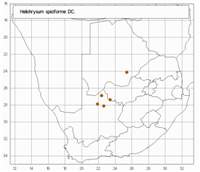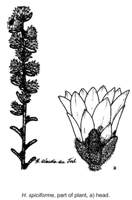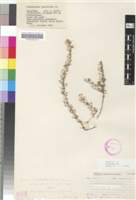Origin of name:
spiciforme= resembling a spike
Diagnostic characters:
Flowering branches with a string of leaf clusters on short stalks, each bearing a single headShort linear woolly leavesWhite bractsMedium-sized solitary heads
Description:
Woody perennial, main branches up to 400 mm long, apparently erect or decumbent, branching above, grey woolly-felted, glandular, leafy, each leaf with a very short (up to 10 mm) closely leafy axillary shoot. Leaves mostly 3-10 (-23) x 1-1.5 (-4) mm, the smallest on the axillary shoots, linear or the largest oblanceolate, obtuse, base broad, half-clasping, margins revolute, both surfaces thickly grey-woolly, glandular. Heads heterogamous, campanulate, c. 7-8 x 5 mm, 10 mm when expanded, solitary, sessile at the tip of each axillary shoot, these racemosely arranged and the whole very floriferous. Involucral bracts in 5-6 series, graded, loosely imbricate, inner exceeding flowers, radiating, tips subopaque, white, very acute. Receptacle nearly smooth. Flowers c. 23-30, 7-11 female, 16-21 homogamous, yellow, tipped pink. Achenes not seen, ovaries with myxogenic duplex hairs. Pappus bristles very many, equaling corolla, scabridulous, bases cohering by patent cilia.
Rarely collected; probably flowers between July and October.
Distribution:
Recorded from Gordonia in the northern Cape (Van Zyl's Rus, Korannaberg, Kuie and Kgop Pans) east to Litakun and SE. to Du Toit's Pan near Kimberley, on deep loose sand. Also in Gobabis district, Namibia and in Botswana.
Savanna Biome.
Taxonomy:
Literature:
Helichrysum spiciforme DC., Prodr. 6: 171 (1838); Harv. in F. C. 3: 216 (1865); Moeser in Bot. Jb. 44: 302 (1910); Merxm., F. S. W. A. 139: 97 (1967).
Type:
Northern Cape, near Takun, Pellat Plains at Jabiru Fountain, Burchell 2247 (G-DC, holo.; BM; BOL; M; P; S; SAM; Z, iso.).
Synonym(s):
Gnaphalium spiciforme (DC.) Sch. Bip. in Bot. Ztg 3: 169 (1845).
Vouchers:
Drake 2247 (PRE); Leistner 2086 (PRE); Tuck SAM 16303 (SAM).

